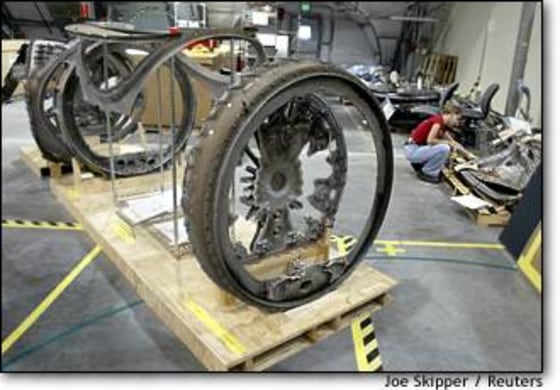Workers at Kennedy Space Center are packing up the 84,000 pieces of the space shuttle Columbia for storage. But unlike debris from the Challenger, some remnants will be available to researchers and perhaps someday put on display in a museum.
“The overall goal... was to make Columbia available to do further science and research, not only by the shuttle community but other contractors, universities and scientists,” said Scott Thurston, who was the vehicle manager for Columbia.
NASA hasn’t decided whether any pieces of the shuttle will ultimately be given to the Smithsonian National Air and Space Museum in Washington, but that institution has the right of first refusal for all excess NASA property.
“They know our interest and they’re considering a variety of options,” said museum space history curator Valerie Neal, who has toured the debris spread out in a space center hangar.
The debris from Challenger was put into two abandoned missile silos at Cape Canaveral Air Force Station after the 1986 disaster. NASA Administrator Sean O’Keefe has vowed that will not happen with Columbia.
Next week, boxes of the collected parts, representing 39 percent of the shuttle, will be trucked 1½ miles (2 kilometers) away to the 16th floor of the Vehicle Assembly Building. That is the building where the shuttle orbiter is attached to the external fuel tank and solid rocket boosters before launches.
Mixed emotions
It is a time fraught with mixed emotions tinged with relief for the workers who combed the woods of east Texas for debris in the weeks after the Feb. 1 disaster, and those who spent months assembling the pieces in the 50,000-square-foot hangar in an effort to identify parts for investigators.
Officials hope to have the hangar cleared by Oct. 1.
“This is rough for me,” said Carl Vita, a technician with NASA’s contractor, United Space Alliance, as he viewed pieces of the fuselage he used to work on.
A parade of NASA contractors, aeronautical designers and crew members, such as astronaut Kevin Kregel who flew on Columbia in 1996 and 1997, have been getting last-minute tours of the debris this week, trying to glean any lessons about the breakup of hypersonic aircraft before the debris is stored away. Kregel examined the debris for work he is doing on the next generation of space transportation, the Orbital Space Plane.
“You see some of the debris and you see why some pieces survived and others didn’t,” Kregel said. “You have all this evidence here that can help.”
No decision on memorials
Besides the Smithsonian, other museums and historical societies also have made requests for debris as have several towns that want to create their own memorials to Columbia. NASA has made no decision on those requests either.
“It’s too early, out of respect for the families of the deceased,” said Jim Hull, manager for exhibits and artifacts at NASA Headquarters in Washington. Seven astronauts were killed aboard Columbia.
Some of Columbia’s largest pieces include the landing gear and the window frame. Pieces most likely to interest researchers include thermal protection tiles and parts of the reassembled left wing where a huge gash let in hot atmospheric gases that brought down the shuttle. The Columbia Accident Investigation Board determined in a hard-hitting report on the disaster that the hole was caused by a chunk of foam insulation that broke off the fuel tank at launch.
About 40,000 of Columbia’s pieces were never identified. More debris likely will be added over time. Every week, Kennedy Space Center workers receive packages containing more debris found in Texas.
“Deer season will be an interesting time,” Vita said. “That’s when we think we’ll get a lot back.”
